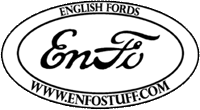
Fordson’s Finest Hour
by Les Foster
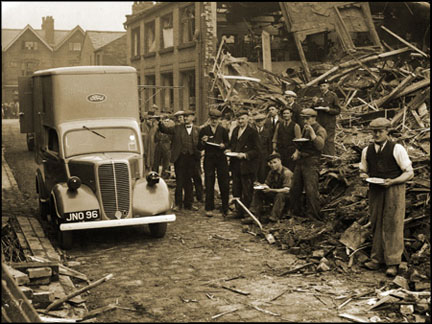 It’s very early Monday morning on Punch St. in Bolton, Lancashire. It has dawned a typical October day, bright with a hint of chill in the air and the strangely altered quality of Autumn light. But nothing else is typical. There is only tangled rubble and death where Punch St. was. Ruth Walley sang at the six o’clock evening church service but was dead before midnight. She was one of the eleven citizens who died last night. Sixty-eight other people were injured. That’s just the way it is on October, 13th, 1941. It is much the same all over Britain- another night, another raid, another morning of sorrow and cleanup. That is the enemy’s whole point, to disrupt the workers’ sleep and their routine and try to break down their morale. No power for lights, no gas for cooking, no sleep, no food. It is tough going on with little good news, year after long year of war.
It’s very early Monday morning on Punch St. in Bolton, Lancashire. It has dawned a typical October day, bright with a hint of chill in the air and the strangely altered quality of Autumn light. But nothing else is typical. There is only tangled rubble and death where Punch St. was. Ruth Walley sang at the six o’clock evening church service but was dead before midnight. She was one of the eleven citizens who died last night. Sixty-eight other people were injured. That’s just the way it is on October, 13th, 1941. It is much the same all over Britain- another night, another raid, another morning of sorrow and cleanup. That is the enemy’s whole point, to disrupt the workers’ sleep and their routine and try to break down their morale. No power for lights, no gas for cooking, no sleep, no food. It is tough going on with little good news, year after long year of war.
This morning, though, there is a tiny spot of simple joy. Down the narrow path cleared by the rescue workers and firemen on Punch St. comes something a bit different. It is a duo-tone grey van, quite shiny, with lots of sign-writing. Everyone recognizes the Ford oval on the front of the body and the familiar shape of a Fordson 10 cwt. But what is it doing, crawling up Punch St. giving little warning “neeps” for weary workers to let it pass? Going as far up the shattered street as it can, it finally halts. The driver disappears into the back for a moment and then the van sides swing up to reveal a canteen on wheels. “Fancy a cuppa, lads?” grins the volunteer driver. The rescue workers, soldiers and some shocked and homeless inhabitants cluster around for a few minutes of normality. A cup of hot tea and a tin plate of breakfast- something to help them cope, to keep them going, to tell them they are not alone.
It was against grim backdrops like this that the Fordson E83W Emergency Food Vans had their finest hour. On March 14th, 1938, just a week before the E83W was introduced to the public, the British Home Secretary took the extraordinary peacetime step of asking for one million volunteers for ARP or Air Raid Precautions work. Women were invited as well as men and were to form one third of the ARP force. Another half-million members of the Woman’s Volunteer Service staffed most of the Food Vans, drove ambulances (many of them ARP Fordsons), cooked meals, led scrap drives, and performed countless tasks to free men for the military. Together with the National Fire Service and the constabulary and others, a vast organization of Civil Defense would fight to keep the nation functioning and defiant. Troops of ENSA entertainers and film units from the Ministry of Information (many travelling by Fordson E83W) took the minds of servicemen and workers off their struggles, if only briefly. A case can be made that these unsung thousands of men and women of all ages whose motto was “we can take it!” were every bit as crucial to the survival of Britain as those “famous few”. It was a case of “many hands make light work”. Morale was as potent a weapon as bombs and keeping it up could sometimes come down to a hot meal and a cup of tea.
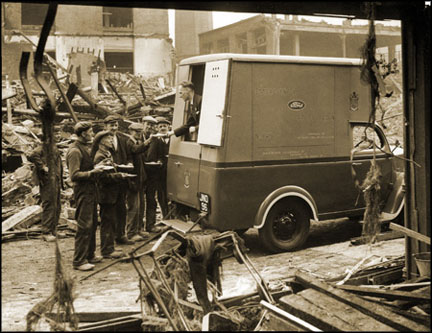 In 1941, Henry and Edsel Ford decided to donate to the people of Britain 450 “Emergency Food Vans”- canteen wagons to deliver relief to the victims of the Blitz. The vehicle chosen to fill this gift was the Ford of England’s E83W 10cwt. Van which was the only civilian Ford still being made at their giant Dagenham works since the outbreak of hostilities. It is rather remarkable that, in this early and uncertain period of the war, Henry Ford, who was an outspoken pacifist and proponent of keeping America out of any European conflicts, should make this gesture. Perhaps, it was more Edsel’s doing.
In 1941, Henry and Edsel Ford decided to donate to the people of Britain 450 “Emergency Food Vans”- canteen wagons to deliver relief to the victims of the Blitz. The vehicle chosen to fill this gift was the Ford of England’s E83W 10cwt. Van which was the only civilian Ford still being made at their giant Dagenham works since the outbreak of hostilities. It is rather remarkable that, in this early and uncertain period of the war, Henry Ford, who was an outspoken pacifist and proponent of keeping America out of any European conflicts, should make this gesture. Perhaps, it was more Edsel’s doing.
Thus the one of the iconic vehicles of the Second World War came into being. Briggs Motor Bodies, Ford’s “captive” body builder, was tasked with converting delivery vans to canteens. The very first of these, Emergency Food Van No.1, was one of the initial batch of 23. Utilizing the cab and lower van sections of the E83W, the food vans’ upper sides were extended to give standing height inside. Rudimentary wooden cabinets, opening side-hatches that doubled as awnings and a simple cooker were fitted. All this was fashioned in a composite metal over wood construction. An eight-day clock was installed in the dash, reflecting an era when a wristwatch might be a luxury not every volunteer could afford. Painted in a light grey over dark grey duo-tone with a red stripe at the beltline, the trucks were distinctively labeled as “Ford Emergency Food Van”. They bore the universally recognized Ford blue oval on the front and sides. The vans were maintained free of charge by local Ford dealers and were sometimes even stored at the local garage. Food Van No. 1 bears signage attesting that it was “Maintained Voluntarily by R.H. Patterson & Co. Ltd. Forth St. Works Newcastle on Tyne”. It was a generous gift and wonderful goodwill for Ford. The fleet was dispersed throughout Britain and a few even went overseas after D-Day.
The meals were pre-cooked and delivered in insulated containers but the all-important tea was brewed onboard. Over two and a half million roadside meals and more than five million school meals were served in the course of accumulating 1,031,490 miles on the vans. They joined many more similar ‘tea vans’ operated by various charities during the war.
The first Ford Emergency Food Van, No.1, now resides in the Canadian War Museum in Ottawa. After an inglorious period of neglect and abandonment by Ford in Dearborn and a stint in private hands, the CWM took ownership of what it considers to be a very important symbol of another side of war- the civilian struggle to hold society together. Jim Whitham, Collections Manager, Transportation and Artillery, is in charge of the van’s restoration. He’s more used to working on tanks like the Canadian RAM that is being refurbished in the same shop. The van still carries its license plate with registration number JNO 421 and a plaque fixed to its side proudly declares that it was inspected by the King and Queen on September 16, 1941. It was then sent off to work in Newcastle on Tyne. Like its sister van, JNO 96 in Bolton and hundreds of others all over Britain, it no doubt saw its share of action.
 I became aware of the Food Van in the mid-1990’s when I read an article about it and even contacted its new owner in Michigan. The price was far too high for me and I heard nothing more of it for many more years. In 2005 my wife, Trisha, and I visited Ottawa but the War Museum was closed pending its move to its splendid new building. Upon arriving home I came across a website that pictured the Food Van in the old (and closed) CWM. I had been so near yet so far from it! I contacted the War Museum and sent them a lot of information on the Ford E83W in the hope of being of assistance in its eventual restoration. They gratefully acknowledged my material and that’s all I heard for more than two years.
I became aware of the Food Van in the mid-1990’s when I read an article about it and even contacted its new owner in Michigan. The price was far too high for me and I heard nothing more of it for many more years. In 2005 my wife, Trisha, and I visited Ottawa but the War Museum was closed pending its move to its splendid new building. Upon arriving home I came across a website that pictured the Food Van in the old (and closed) CWM. I had been so near yet so far from it! I contacted the War Museum and sent them a lot of information on the Ford E83W in the hope of being of assistance in its eventual restoration. They gratefully acknowledged my material and that’s all I heard for more than two years.
In early 2008 I received an email from Dan Guther, a volunteer with the CWM, who was helping to restore Emergency Food Van No. 1. He and fellow volunteer, Ken Goodbody, needed help with the steering column lock on the Food Van. I was able to dispatch exploded drawings and text explaining the steering lock setup. This was the beginning of a steady correspondence with Dan who sought advice on the restoration and in turn kept me abreast of its progress. A rather unlikely War Museum volunteer, Dan is a minister and theology student. It was an interest in old vehicles and the Food Vans’s mission of mercy that attracted him to the project.
 In late April 2008, my son Ryan (who is a history major at the University of Victoria) and I flew to Ottawa to see the Food Van and tour the Canadian War Museum. We were graciously received by Jim Whitham and by Angus Brown who represented the Friends of the Canadian War Museum, a volunteer group which helps support the museum through fundraising. Angus urged us to spread the word that this very important Canadian institution needs your active support. To that end, I was pleased to be able to donate some parts for the Food Van restoration project. We were given a personal tour of the restoration shop which featured Food Van No. 1, a RAM tank, and even a rare piloted version of the V-1 “buzz-bomb” smuggled out of occupied Germany by a young Canadian Intelligence officer named Farley Mowatt. It was rather like being in Alladin’s cave! Afterwards we were turned loose to wander the museum for the rest of the day. It is an awesome collection and the evocative and thought-provoking displays reminded us of the sacrifice that has helped make Canada the respected nation it is today.
In late April 2008, my son Ryan (who is a history major at the University of Victoria) and I flew to Ottawa to see the Food Van and tour the Canadian War Museum. We were graciously received by Jim Whitham and by Angus Brown who represented the Friends of the Canadian War Museum, a volunteer group which helps support the museum through fundraising. Angus urged us to spread the word that this very important Canadian institution needs your active support. To that end, I was pleased to be able to donate some parts for the Food Van restoration project. We were given a personal tour of the restoration shop which featured Food Van No. 1, a RAM tank, and even a rare piloted version of the V-1 “buzz-bomb” smuggled out of occupied Germany by a young Canadian Intelligence officer named Farley Mowatt. It was rather like being in Alladin’s cave! Afterwards we were turned loose to wander the museum for the rest of the day. It is an awesome collection and the evocative and thought-provoking displays reminded us of the sacrifice that has helped make Canada the respected nation it is today.
Dan and Ken were hard at work on the Fordson Food Van’s chassis. The body had been removed and various parts were set in neat piles around the shop pending further attention. I spent quite some time examining the dismembered Food Van, trying to visualize it as it was over sixty years ago.
While the 1941 model was essentially the same as the E83W’s of the 1950’s there were interesting little differences that caught my eye. First of all, seeing a right hand drive model was a novelty for a North American Thames E83W owner. Many of the differences relate to the E83W’s offset drivetrain which in the British version is offset to the left of centre. The greater amount of space available for the driver’s footwell due to the absence of manifolds on the right side of the engine allowed under-bonnet battery storage and some other minor differences from our LHD units. Of course there are obvious differences all the way down the offset drivetrain and in the braking system linkages and such, but on the whole it is very similar to the LHD models in concept.
The most obvious tip-off to the van’s age is the single starting-handle hole in the bottom left side of the grill. Postwar E83W’s have two crank holes to allow for either mounting of the engine- a cost-saving item in the great “Export or Die” era. The Food Van is badged as a “Fordson”- another novelty for the North American E83W owner as the “Thames” name was reserved for export models until it supplanted “Fordson” in the UK, too, during the 50’s. Food Van No. 1 has wartime masks over its bulb-type headlamps which incorporate the sidelamps within their reflectors. Thus there are no separate sidelamp pods as we are used to on Thames over here. The headlamps are the larger size units rather than the very small ones often fitted during the war. Another visual cue to the van’s age is the front door windows. There are no plated pull-up handles on the top edge of the door glass. This is because until postwar, all E83Ws enjoyed the luxury of wind-up windows. Going around to the rear, the flat, un-flared, sides behind the rear fenders mark this as an early model as do the un-beaded front fenders. These are all differences that only an enthusiast would notice. At a glance the 1941 Fordson and the 1951 Thames would appear almost identical to the vast majority of people. I believe that is one of the appealing points of E83W ownership, today. They are truly “time machines”.
Under the skin there are likewise only minor differences from the later models. The flat bar-like shock absorber links caught my eye. They are quite different from the post-war “dog bones” or even the contemporary two-piece pressed links used by American Ford cars. The steering box and the horn were slightly different in appearance to later models, too, but there are really very few differences in the chassis and running gear from the postwar E83W’s.
Interestingly, the Food Van was fitted with 6:00-16 tires, a departure from the 5:00-18 size standard on E83W vans of the time. A period chart that I obtained lists the E83W “Mobile Canteen” and shows it fitted with 6:00-16 tires on the front and 6:50-16’s on the rear. I surmise that this was to try to bring down the high and narrow Food Vans’ centre of gravity, aid stability and help carry the extra weight of the loaded canteen. Postwar North American E83W’s all had 6:00-16 tires as standard equipment.
 Under the bonnet, the ’41 model differed only slightly from later examples, too. The first thing that presented itself was the much simpler oil filler/breather spout. This was a plain vertical tube with a small steel cap- much more utilitarian than the bent pipe topped with the built-in oil funnel and hinged lid fitted after the war. The generator had a much different mounting. A one-piece pressed bracket sat atop the cylinder head and cradled the generator body which is of the three brush type and is mated with a simple cut-out rather than the more sophisticated regulator (and two brush generator) used later on. No oil filter was fitted nor any water pump and a small plate over the carburetor sufficed in place of an air cleaner.
Under the bonnet, the ’41 model differed only slightly from later examples, too. The first thing that presented itself was the much simpler oil filler/breather spout. This was a plain vertical tube with a small steel cap- much more utilitarian than the bent pipe topped with the built-in oil funnel and hinged lid fitted after the war. The generator had a much different mounting. A one-piece pressed bracket sat atop the cylinder head and cradled the generator body which is of the three brush type and is mated with a simple cut-out rather than the more sophisticated regulator (and two brush generator) used later on. No oil filter was fitted nor any water pump and a small plate over the carburetor sufficed in place of an air cleaner.
Looking inside the cab, I was immediately impressed by the attractive instruments used on these early E83W’s. The speedometer used a white background with an inner band of black on which the white speed numbers were printed. A red line marked 30 M.P.H. and the bottom of the black band incorporated the Ford oval and script. The maker’s name “AC” was printed on the face above the odometer. The Petrol and Amperes gauges were white with black numbering and graduations. Dashboard controls were arranged exactly as in postwar vans except the choke knob was a chromed ball-shape (original or not?) and the starter pull had been replaced by a push-button- no doubt a postwar solenoid modification that replaced the original cable pull and mechanical switch. There was also the white-faced clock marked “8 Day” adorning the dash to the left of the other gauges. An early-type dome light with round lamp mounted on a mantle-clock-shaped plywood base was affixed to the cab ceiling. These type lamp units are common to E83W’s up to around 1949. Beside the driver’s seat on the right was a pull-up type handbrake lever. This was replaced after the war with the “umbrella” style under-dash handle. The steering wheel was a thicker-rimmed three spoke type with a slight dish to it rather than the lighter, flatter wheel used later and the column incorporated a combination steering and ignition lock. Being RHD, the cab floor panel incorporated a trapezoidal tool box with hinged lid on the left (passenger) side and no opening beneath the driver’s seat (unlike LHD models which have a rectangular right side tool box and a similarly-shaped battery box beneath the driver). I didn’t get a good look at the front seats (which had been removed) but believe they are of the separate cushion and backrest style with the passenger seat being hinged to provide access to the under-floor tool box. The cab ceiling is wood being actually the underside of a two-shelf storage cabinet built inside the high roof over the cab. There is a wooden wall behind the cab with an opening in between the seats to access the canteen area. On the wall behind the driver’s seat is a narrow, vertical upholstered pad to act as a headrest. Below this, at floor level, on the wall is a sheet metal document tray behind the driver’s seat for orders, etc. The typical pressed steel E83W cab step is fitted to both sides of the van. The cab interior, including the dashboard, was all painted in a pale green colour reminiscent of government offices of the period.
 The canteen area was all painted white. In addition to the over-cab storage there are two cabinets, one on each side with a central aisle to stand in. The cabinets have counter tops and two shelves, with the floor forming a third level of storage beneath them. The shelves are open, probably because there is no room for hinged doors to operate in the narrow confines of the canteen. Hooded six-volt lamps were provided at each end of the left counter with a toggle switch mounted on the forward bulkhead. Cast-iron, cooking elements originally sat on short legs atop the right-side counter to boil water for the tea. These units, with small fuel tanks like camping stoves, were sitting on the shop floor when I saw the van but their purpose was unmistakable. A portable water carboy could be placed on the cookers for heating. There was what appeared to be a wooden mug rack above the right-hand counter. A two-piece “Dutch door” provides access to the canteen body from outside the van via a folding step at the rear. It was all extremely utilitarian- just two wooden counters with shelves to hold the pre-prepared meal tins, a cupboard or two for biscuits, something to heat water for tea, racks for mugs and a place to stand. Hinged side-panels tilted up to form canopies, and the left–side counter-top had an additional section that flipped down to provide a serving ledge to the public. All this formed a tiny, simple, oasis of calm amidst a nightmare of death and destruction.
The canteen area was all painted white. In addition to the over-cab storage there are two cabinets, one on each side with a central aisle to stand in. The cabinets have counter tops and two shelves, with the floor forming a third level of storage beneath them. The shelves are open, probably because there is no room for hinged doors to operate in the narrow confines of the canteen. Hooded six-volt lamps were provided at each end of the left counter with a toggle switch mounted on the forward bulkhead. Cast-iron, cooking elements originally sat on short legs atop the right-side counter to boil water for the tea. These units, with small fuel tanks like camping stoves, were sitting on the shop floor when I saw the van but their purpose was unmistakable. A portable water carboy could be placed on the cookers for heating. There was what appeared to be a wooden mug rack above the right-hand counter. A two-piece “Dutch door” provides access to the canteen body from outside the van via a folding step at the rear. It was all extremely utilitarian- just two wooden counters with shelves to hold the pre-prepared meal tins, a cupboard or two for biscuits, something to heat water for tea, racks for mugs and a place to stand. Hinged side-panels tilted up to form canopies, and the left–side counter-top had an additional section that flipped down to provide a serving ledge to the public. All this formed a tiny, simple, oasis of calm amidst a nightmare of death and destruction.
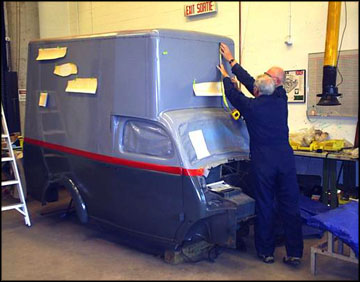 Another interesting part of the Emergency Food Van is its commission plate. This small square polished aluminum plate, attached by screws to the firewall, shows the engine number and model number of the vehicle. Usually headed by the Ford script and the legend “Made in England” in bare metal on a painted black background, this Food Van’s commission plate’s upper-half has been painted over in olive drab and the capital letters, “FMCL” (Ford Motor Company Limited) have been stamped into it- perhaps to indicate that these vehicles were donated to the people of Britain by Ford U.S.A.
Another interesting part of the Emergency Food Van is its commission plate. This small square polished aluminum plate, attached by screws to the firewall, shows the engine number and model number of the vehicle. Usually headed by the Ford script and the legend “Made in England” in bare metal on a painted black background, this Food Van’s commission plate’s upper-half has been painted over in olive drab and the capital letters, “FMCL” (Ford Motor Company Limited) have been stamped into it- perhaps to indicate that these vehicles were donated to the people of Britain by Ford U.S.A.
Also of interest is the Food Van’s Briggs Body Number tag. The tag reads, “513/87”. This is a bit of a mystery as conventional wisdom has it that code “513” denotes an E83W van and “87” would be its consecutive build number. With the E83W having been put into production in the Spring of 1938 and this Food Van being presented in the Autumn of 1941, it seems like the production number is numerically far too low. Could Food Van No. 1 have been converted from an early production example? Could Briggs have used a body set aside for training or measurement purposes to develop this prototype or was a used van body converted and mated with a new chassis and engine? Perhaps there is another explanation for what seems to be an anomaly.
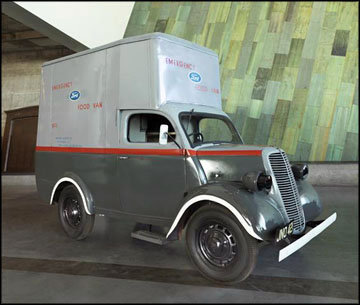 By the end of 2008, restoration of Emergency Food Van No.1 was very nearly complete. The Canadian War Museum staff and volunteers have done a remarkably faithful and sympathetic job of returning this vehicle to the state in which it would have appeared to the thousands of civilians and servicemen that enjoyed its mercies in the dark days of the Second World War. It will take its place in the collection beside famous machines of war and if it could have a memory it might smile to think not only of the King and Queen who inspected it once but more especially of the comfort it brought to the many ordinary people who looked forward to its arrival in their hour of need.
By the end of 2008, restoration of Emergency Food Van No.1 was very nearly complete. The Canadian War Museum staff and volunteers have done a remarkably faithful and sympathetic job of returning this vehicle to the state in which it would have appeared to the thousands of civilians and servicemen that enjoyed its mercies in the dark days of the Second World War. It will take its place in the collection beside famous machines of war and if it could have a memory it might smile to think not only of the King and Queen who inspected it once but more especially of the comfort it brought to the many ordinary people who looked forward to its arrival in their hour of need.
Sources:
Canadian War Museum
English & Australian Small Fords Recognition & Restoration -Bill Ballard, Ellery Publications 2002
Mr. Fordson’s War -Les Foster
Ottawa Citizen, “Special Wartime Delivery”-Dave Brown, April 7th, 2008
R.E.S.P.E.C.T. -Les Foster
Sidevalve News (Ford Sidevalve Owners Club)
The Night Blitz 1940-1941 -John Ray, Castle Books 2004
Bolton Remembers the War